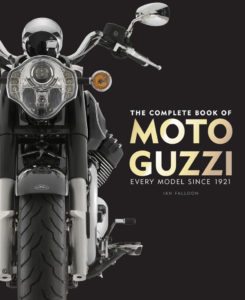
Anyone wanting to know anything and everything about Moto Guzzis, “The Complete Book of Moto Guzzi” is the place to go. Ian Falloon is a well-known motorcycle historian, with many books to his name. He is especially fond of Italian marques and this volume really does answer all the questions any Guzzi owner might have. And tell him a lot he does not know.
My own introduction to Guzzis was when I was 16 and my professorial father took a sabbatical to Rome. The manager of our apartment building had a Guzzino, or Motoleggera 65, a little two-stroke made from 1946 to 1954. It was not until I read Falloon’s book that I realized this basic transportation sold so well it put the financially challenged firm back on solid economic footing following World War II and allowed the company to get back into racing, an Italian passion.
The Guzzi marque was begun in 1921 by Carlo Guzzi, a World War I (in that war Italy was on the American side) pilot, and two of his buddies. First model was the Normale, a four-stroke 500cc single, engine pointing forward. And this horizontal engine was very much the Guzzi image for the next 45 years, with its signature outside flywheel—or salami slicer, as some called it. The size of the single ran from 175 to 500cc, and the racing versions were quite successful. Racing was important to sales, and in the 1930s Guzzi also had a transverse-mounted four-cylinder engine, as well as a transverse (like Ducati) 120-degree V-twin and a supercharged 500cc triple.
The aftermath of WWII required much change. The Guzzi factory had not been bombed, but the 250 and 500cc singles were way too expensive for the average Italian, so soon an array of smaller bikes like the Guzzino and 160cc Galletto were on the market. And the OHC 175 Lodola appeared to compete in the Motogiro d’Italia, a long race on public roads with 175cc being the biggest engine allowed. In the 1950s a lot of money was frittered away on questionable enterprises like the 500cc V-8 GP bike—which was raced briefly and not very successfully. The company bowed out of GP racing in 1958. Carlo Guzzi died in 1964, and then a whole new approach was taken, beginning with the development of a large V-twin that would be used by the police and military.
In the early 1960s a New Jersey outfit called Premier Motor Corporation was bringing in some small Guzzi 125cc models, but most Americans did not become familiar with the Guzzi product until the V7 appeared on these shores in 1967. This was an OHV 90-degree 703cc V-twin, cylinders sticking out sideways, with the ads boasting 50 horsepower at 5,800 rpm, a 12-volt battery, electric starting and twin-leading-shoe front brake. Joe Berliner took over Premier and convinced Guzzi to up the size to a more conventional 750cc—and an extra five horses. Berliner called the model the Ambassador. Since then more than a hundred different V-twin versions have followed, from 350cc to 1,400cc, including straight OHV two-valve engines or OHC four-valve.
Today Piaggio owns the Moto Guzzi marque, which is best known for its Vespas. Let me make one thing perfectly clear: this is not bedtime reading. The 10 x 12 inch book has 260 pages, weighs a hefty four pounds and a $60. “The Complete Book of Moto Guzzi” is published by Motorbooks and can be ordered at any bookstore. For more information, visit the website of Motorbooks’ parent company, QuartoKnows.com.









I love these bike “coffee table” books; even more when they’re hefty and still more when the bikes are still in production. Wish two of the loves I ride, the Honda VFR and the Suzuki V-Strom, were sexy enough to be between the covers. Hmmmm, that may not be the best way to put it . . .